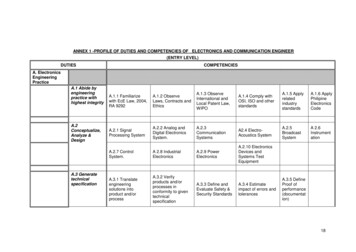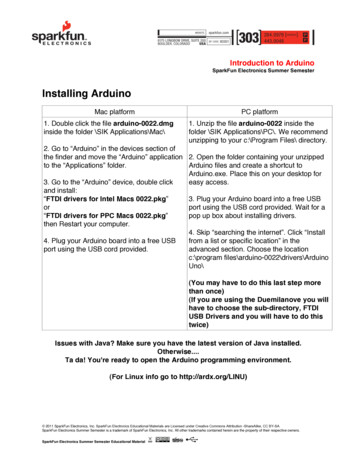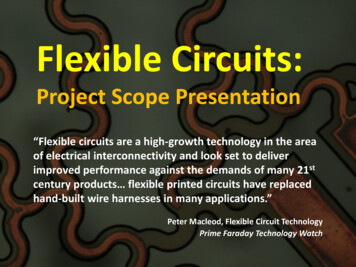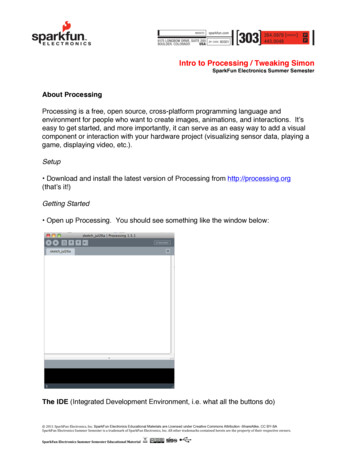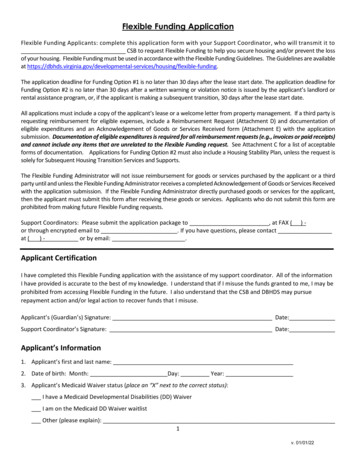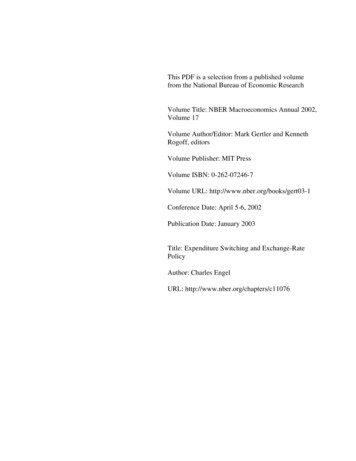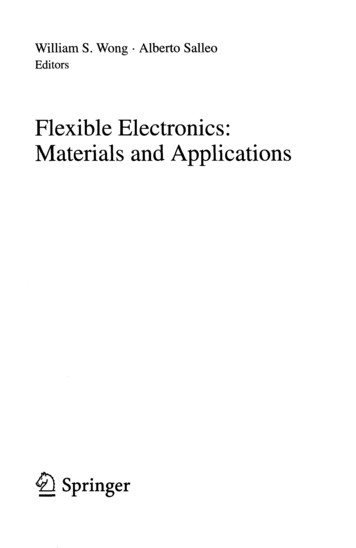
Transcription
William S. Wong Alberto SalleoEditorsFlexible Electronics:Materials and ApplicationsS Springer
Contents1 Overview of Flexible Electronics TechnologyI-Chun Cheng and Sigurd Wagner1.1History of Flexible Electronics1.2Materials for Flexible Electronics1.2.1Degrees of Flexibility1.2.2Substrates1.2.3Backplane Electronics1.2.4Frontplane Technologies1.2.5Encapsulation1.3 Fabrication Technology for Flexible Electronics1.3.1Fabrication on Sheets by Batch Processing1.3.2Fabrication on Web by Roll-to-Roll Processing1.3.3Additive Printing1.4OutlookReferences2 Mechanical Theory of the Film-on-Substrate-Foil Structure:Curvature and Overlay Alignment in Amorphous SiliconThin-Film Devices Fabricated on Free-Standing Foil SubstratesHelena Gleskova, I-Chun Cheng, Sigurd Wagner, and Zhigang Suo2.1 Introduction2.2 Theory2.2.1The Built-in Strain ebi2.3 Applications2.3.1Strain in the Substrate, s(Trf), and the Film, е/(Т ),at the Deposition Temperature Tj2.3.2Strain in the Substrate, e s (T r ), and the Film, 6/(T r ),at Room Temperature T r2.3.3Radius of Curvature R of the Workpiece2.3.4Strain of the Substrate and the Curvature of theWorkpiece for a Three-Layer Structure2.3.5Experimental Results for a-Si:H TFTs Fabricated ix
ContentsX2.4 ConclusionsReferencesLow-temperature Amorphous and Nanocrystalline SiliconMaterials and Thin-film TransistorsAndrei Sazonov, Denis Striakhilev, and Arokia Nathan3.1 Introduction3.2Low-temperature Amorphous and NanocrystallineSilicon Materials3.2.1Fundamental Issues for Low-temperature Processing3.2.2Low-temperature Amorphous Silicon3.2.3Low-temperature Nanocrystalline Silicon3.3 Low-temperature Dielectrics3.3.1Characteristics of Low-temperature DielectricThin-film Deposition3.3.2Low-temperature Silicon Nitride Characteristics3.3.3Low-temperature Silicon Oxide Characteristics3.4 Low-temperature Thin-film Transistor Devices3.4.1Device Structures and Materials Processing3.4.2Low-temperature a-Si:H Thin-Film TransistorDevice Performance3.4.3Contacts to a-Si:H Thin-film Transistors3.4.4Low-temperature Doped nc-Si Contacts3.4.5Low-temperature nc-Si TFTs3.5 Device Stability3.6Conclusions and Future ProspectiveReferencesAmorphous Silicon: Flexible Backplane and Display Application . . . .Kalluri R. Sarma4.1 Introduction4.2 Enabling Technologies for Flexible Backplanes and Displays4.2.1Flexible Substrate Technologies4.2.2TFT Technologies for Flexible Backplanes4.2.3Display Media for Flexible Displays (LCD,Reflective-EP, OLED)4.2.4Barrier Layers4.3Flexible Active Matrix Backplane Requirementsfor OLED Displays4.3.1Active Matrix Addressing4.4 Flexible AMOLED Displays Using a-Si TFT Backplanes4.4.1Backplane Fabrication Using PEN Plastic Substrates4.4.2Flexible OLED Display Fabrication4.4.3Flexible AMOLED Display Fabricationwith Thin-film 77070757576768289909192959598100
ContentsFlexible Electrophoretic Displays Fabricatedusing a-Si TFT Backplanes4.6Outlook for Low-Temperature a-Si TFT for FlexibleElectronics ManufacturingReferencesxi4.55 Flexible Transition Metal Oxide Electronics and ImprintLithographyWarren В. Jackson5.1 Introduction5.2 Previous Work5.3Properties of Transistor ontact Materials5.4 Device Structures5.5 Fabrication on Flexible Substrates5.5.1Imprint Lithography5.5.2Self-Aligned Imprint Lithography5.5.3SAIL Transistor Results5.5.4Summary of Imprint Lithography5.6 Flexible TMO Device Results5.7 Future Problems and Areas of Research5.7.1Carrier Density Control5.7.2Low-Temperature Dielectrics5.7.3Etching of TMO Materials5.7.4P-type TMO5.7.5Stability5.7.6Flexure and Adhesion of TMO5.7.7Flexible Fabrication Method Yields5.8SummaryReferences6 Materials and Novel Patterning Methods for FlexibleElectronicsWilliam S. Wong, Michael L. Chabinyc, Tse-Nga Ng,and Alberto Salleo6.1 Introduction6.2 Materials Considerations for Flexible Electronics6.2.1Overview6.2.2Inorganic Semiconductors and Dielectrics6.2.3Organic Semiconductors and Dielectrics6.2.4Conductors6.3 Print-Processing Options for Device 38139143143145145145146149150150
xiiContents6.3.2Control of Feature Sizes of Jet-Printed Liquids6.3.3Jet-Printing for Etch-Mask Patterning6.3.4Methods for Minimizing Feature Size6.3.5Printing Active Materials6.4 Performance and Characterization of Electronic Devices6.4.1Overview6.4.2Bias Stress in Organic Thin-Film Transistors6.4.3Nonideal Scaling of Short-Channel Organic TFTs6.4.4Low-Temperature a-Si:H TFT Device Stability6.4.5Low-temperature a-Si:H p-i-n Devices6.5 Printed Flexible Electronics6.5.1Overview6.5.2Digital Lithography for Flexible Image SensorArrays6.5.3Printed Organic Backplanes6.6 Conclusions and Future ProspectsReferences7 Sheet-Type Sensors and ActuatorsTakao Someya7.1 Introduction7.2Sheet-type Image Scanners7.2.1Imaging Methods7.2.2Device Structure and Manufacturing Process7.2.3Electronic Performance of Organic Photodiodes7.2.4Organic Transistors7.2.5Photosensor Cells7.2.6Issues Related to Device Processes: Pixel Stabilityand Resolution7.2.7A Hierarchal Approach for Slow Organic Circuits7.2.8The Double-Wordline and Double-Bitline Structure7.2.9A New Dynamic Second-Wordline Decoder7.2.10 Higher Speed Operation with Lower PowerConsumption7.2.11 New Applications and Future Prospects7.3Sheet-Type Braille Displays7.3.1Manufacturing Process7.3.2Electronic Performance of Braille Cells7.3.3Organic Transistor-based SRAM7.3.4Reading Tests7.3.5Future Prospects7.4 9199200201201204210211212212213
xiiiOrganic and Polymeric TFTs for Flexible Displays and CircuitsMichael G. Kane8.1Introduction8.2 Important Organic TFT Parameters for Electronic Systems8.2.1Field-Effect Mobility8.2.2Threshold Voltage8.2.3Subthreshold Swing8.2.4Leakage Currents8.2.5Contact Resistance8.2.6Capacitances and Frequency Response8.2.7TFT Nonuniformity8.2.8Bias-Stress Instability and Hysteresis8.3Active Matrix Displays8.3.1Introduction8.3.2Liquid Crystal and Electrophoretic Displays8.4Active Matrix OLED Displays8.4.1Introduction8.5Using Organic TFTs for Electronic Circuits8.5.1Thin-Film Transistor Circuits8.5.2Frequency Limitations of OTFTs8.5.3Integrated Display Drivers8.5.4Radio Frequency Identification Tags8.6 ConclusionReferencesSemiconducting Polythiophenes for Field-Effect TransistorDevices in Flexible Electronics: Synthesis and Structure PropertyRelationshipsMartin Heeney and Iain McCulloch9.1 Introduction9.2 Polymerization of Thiophene Monomers9.2.1General Considerations9.2.2Synthetic Routes for the Preparation of ThiophenePolymers9.3 Poly(3-Alkylthiophenes)9.3.1Electrical Properties9.3.2Thin-film Device Processing and Morphology9.3.3Doping and Oxidative Stability9.4 Polythiophene Structural Analogues9.5 Thienothiophene 6288292293
xiv10 Solution Cast Films of Carbon Nanotubes for TransparentConductors and Thin Film TransistorsDavid Hecht and George Grüner10.1 Introduction: Nanoscale Carbon for Electronics,the Value Proposition10.2 Carbon NT Film Properties10.2.1 Carbon Nanotubes: The Building Blocks10.2.2 Carbon Nanotube Network as an Electronic Material10.2.3 Electrical and Optical Properties of NT Films10.2.4 Doping and Chemical Functionalization10.3 Fabrication Technologies10.3.1 Solubilization10.3.2 Deposition10.4 Carbon NT Films as Conducting and OpticallyTransparent Material10.4.1 Network Properties: Sheet Conductance and OpticalTransparency10.4.2 Applications: ITO Replacement10.4.3 Challenges and the Path Forward10.5 TFTs with Carbon Nanotube Conducting Channels10.5.1 Device Characteristics10.5.2 Device Parameters10.5.3 Challenges and the Path Forward10.6 ConclusionsReferences11 Physics and Materials Issues of Organic PhotovoltaicsShawn R. Scully and Michael D. McGehee11.1 Introduction11.2 Basic Operation11.2.1 Photocurrent11.2.2 Dark Current11.3 Organic and Hybrid Solar Cell Architectures11.4 Materials11.5 Light Absorption11.6 Exciton Harvesting11.6.1 Effects of Disorder11.6.2 Extrinsic Defects11.6.3 Measuring Exciton Harvesting11.6.4 Approaches to Overcome Small Diffusion Lengths11.7 Exciton Dissociation11.8 Dissociating Geminate Pairs11.9 Heterojunction Energy Offsets11.10 Charge Transport and Recombination11.10.1 Diffusion-Limited 34334338340344344347349351355357359
Contents11.10.2 Interface-Limited (Back Transfer Limited)Recombination11.10.3 Measurements Relevant for Extracting Charge11.11 Nanostractures11.12 Efficiency Limits and OutlookReferences12 Bulk Heterojunction Solar Cells for Large-Area PV Fabricationon Flexible SubstratesС Waldauf, G. Dennler, P. Schilinsky, and С J. Brabec12.1 Introduction and Motivation12.1.1 Photovoltaics12.1.2 Technology Overview12.1.3 Motivation for Large-Area, Solution-ProcessablePhotovoltaics12.2 The Concept of Bulk Heterojunction Solar Cells12.2.1 Basics of Organic Solar Cell Materials12.2.2 Fundamentals of Photovoltaics12.2.3 Understanding and Optimization of BHJ Composites . . . .12.3 Challenges for Large-Area Processing12.3.1 Production Scheme12.3.2 Encapsulation of Flexible Solar Cells12.4 37537737737838540140140440840913 Substrates and Thin-Film Barrier Technology for FlexibleElectronicsAhmet Gün Erlat, Min Yan, and Anil R. Duggal13.1 Introduction13.2 Barrier Requirements13.2.1 Generic Requirements13.2.2 Substrate-Specific Requirements13.3 Thin-Film Barrier Technology13.3.1 Historical Background13.3.2 Permeation Measurement Techniques13.3.3 Permeation Through Thin-Film Barriers13.4 Barrier-Device Integration13.4.1 Substrate and Barrier Compatibility with OLEDs13.4.2 Thin-Film Encapsulation13.5 Concluding 442442Index451413
4.2.1 Flexible Substrate Technologies 76 4.2.2 TFT Technologies for Flexible Backplanes 82 4.2.3 Display Media for Flexible Displays (LCD, Reflective-EP, OLED) 89 4.2.4 Barrier Layers 90 4.3 Flexible Active Matrix Backplane Requirements for OLED Displays 91 4.3.1 Active Matrix Addressing 92 4.4 Flexible AMOLED Displays Using a-Si TFT Backplanes 95



